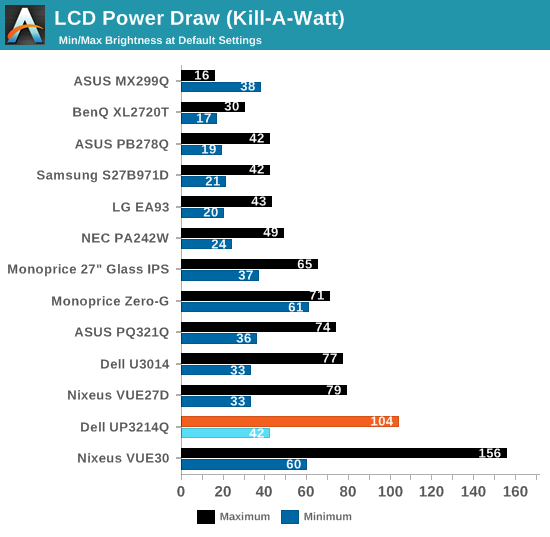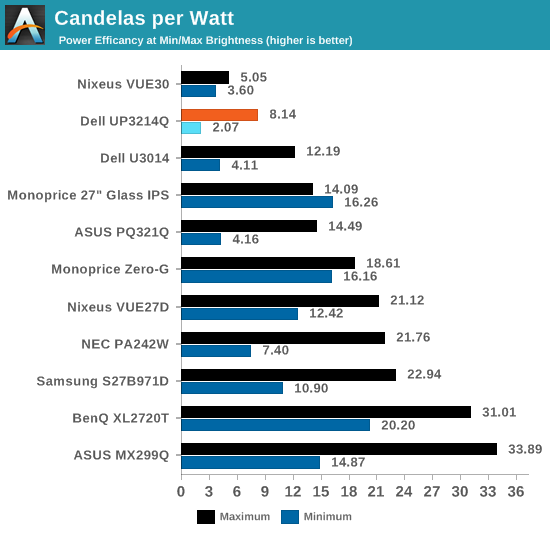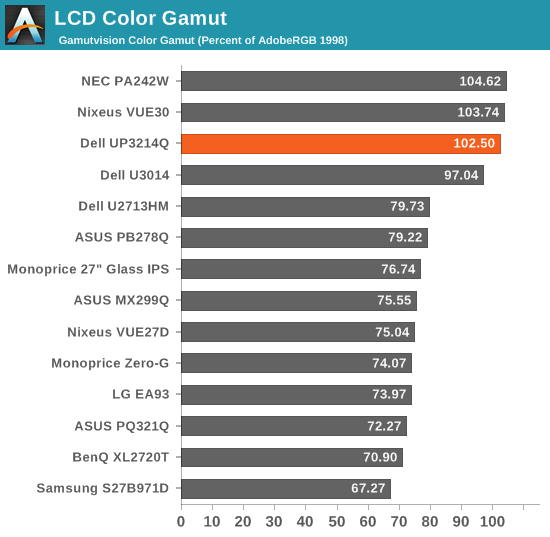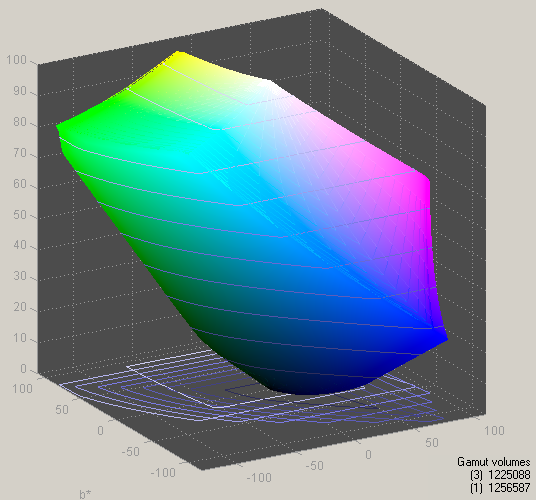Dell UP3214Q Review
by Chris Heinonen on April 1, 2014 12:00 AM ESTUsing the Leo Bodnar lag tester, I measure 47ms of lag on the UP3214Q using a 1080p signal. Without a game mode or anything else to speed up this processing, this is fairly slow. Most people probably won’t be playing many games at native UltraHD resolutions due to the graphics hardware required so measuring a non-native resolution signal, while never ideal, is probably closer to a real world situation here. For many people this will be too slow for gaming. This measurement is also done over HDMI, while almost everyone will use DisplayPort with this monitor to get 60 Hz, so that is another variable that might be different as well.

As a 32” display the UP3214Q is going to use power, and it consumes a decent amount. With the backlight at minimum is consumes 42 watts, and that climbs to 104 watts at maximum backlight. However this power use is still below the 30” Nixeus display that was recently reviewed, and even the 27” NEC PA271W professional display. The UP3214Q is less power efficient than either of those displays as they both have a higher maximum and minimum light output, even with the smaller screens.


The color gamut data has the same issue as the AdobeRGB data. A bug in the calibration has caused the gamut numbers to be off, so I’m reporting two different results. The one from my calibration is 82.7% of the AdobeRGB gamut. Using the included Dell ICC profile, it has 102.5% of the AdobeRGB gamut. Since the pre-calibration numbers appear to support the Dell ICC profile, I will say that the Dell UP3214Q supports the full AdobeRGB gamut as the specs say.












84 Comments
View All Comments
Samus - Tuesday, April 1, 2014 - link
For <$400 and 2560x1440, I'll take a thick (matte finish) bezel with an IPS panel. Infact, I'll take 6 of them and keep the change instead of buying a "Dell"Samsung just announced a direct-competitor to this monitor for $800 starting price. So maybe just 3 of those and keep the change, and they have a razor thin bezel and aluminum frame construction.
I mean...I just can't get over the price here. $2800 bucks. It's not even worth $1000.
inighthawki - Tuesday, April 1, 2014 - link
Are you referring to the ud590? It's hardly a "direct competitor." It's not only 4" diagonal smaller but it's a TN panel, and lacks quite a few input types. Or are you referring to the ud970, in which case would you please post a source to the $800 price tag, which sounds unlikely.On top of that, remember that you then need 2 video cards to power 4/6 monitors (nvidia supports 4 but only in span with the fourth as an "extra" display) so you won't even be able to tile them properly by default. On top of that have fun trying to play a game across all the monitors. At least with a single 4K display you can render at 1080p and have a seamless scaling across the entire display. With 4 or 6 monitors you'd have to run it in the standard "eyefinity" style 3x1 configuration which is nice, but also will cost you with resolution. At that point you're going to need not just two GPUs, but likely two high end GPUs. When all is said and done I don't think you'll save much once you take into account the disadvantages of the setup on top of the price.
nevertell - Tuesday, April 1, 2014 - link
You have never been truly productive with a computer, have you ?A multi monitor setup enables me to do things just that much faster. While you could argue that a 4K monitor would allow me to do stuff side by side on the same panel, at the end of the day, when the new resolution becomes the norm, you have to develop content for 4k. And the only way to see your results is to see them at 4k, so you have to have another panel. Single display setups are meant for lazy office people and content consumers. And even then, playing a game with a surround monitor setup is much nicer than having one large monitor.
People used the same kind of software back in the days of 1280 by 1024, 1024 by 768 and 800 by 640. And even though most of the software for today is written for 1080p or 1200p panels, the fact still remains, you cannot operate Visual Studio in half of that. Hell, it's a nightmare to run Visual Studio on 1336 by 768, let alone something like 960 by 1080p. Even though application UI's appear scalable, scaling them is a last resort. So yes, when we will catch up to 4K on the software side of things, we will need multiple monitors again. But yes, of course, for a web developer of today, being able to edit multiple stylesheets, javascript and html files at the same time AND seeing the result largely in scale is truly great. Unfortunately, most enterprise developers rarely need to edit countless files at once and the php/css people just simply will not be able to afford these displays.
Sabresiberian - Sunday, April 6, 2014 - link
What do you mean by "run 4K at 1080p"? That makes no sense.If you are talking running those 4 monitors to get a total screen space of 3840x2160, sure, you could do that, but you entirely miss the point of having a high-density monitor. The pixels on a 39" 1080p screen are the size of a truck. Maybe suitable for using as a TV viewed across your living room, but not as a monitor a couple of feet from your face.
mczak - Tuesday, April 1, 2014 - link
A wall of TN panels is fairly pointless if you can only see the center one due to the poor viewing angles :-).cheinonen - Tuesday, April 1, 2014 - link
AdobeRGB vs. sRGB, HiDPI vs. Regular DPI, Apples to Orangescheinonen - Tuesday, April 1, 2014 - link
I tested with both Nvidia and AMD cards and had the same issues with both.toncij - Sunday, April 6, 2014 - link
Yes, that information could help, since not every test was done on Nvidia/AMD and the same driver. Also, it would help a lot to hear if those problems also happen with ASUS and Sharp, to compare those products. Anandtech made a review already: http://www.anandtech.com/show/7157/asus-pq321q-ult...jasonelmore - Tuesday, April 1, 2014 - link
Where the hell is HDMI 2.0? Its done and being produced, why isnt it in these new devices?SunLord - Tuesday, April 1, 2014 - link
It takes more then 6months to go from a finished standard to fully certified working silicon let along shipping it in quantities to enable mass production of consumer devices.